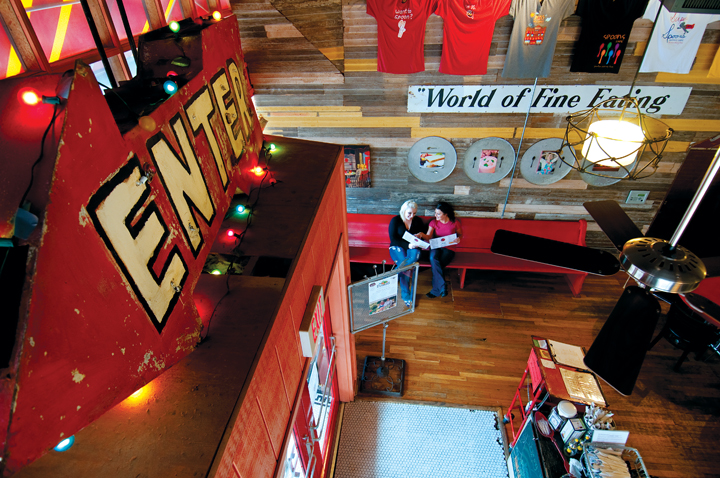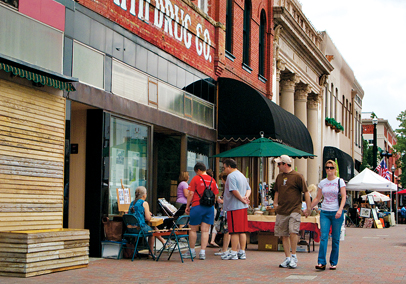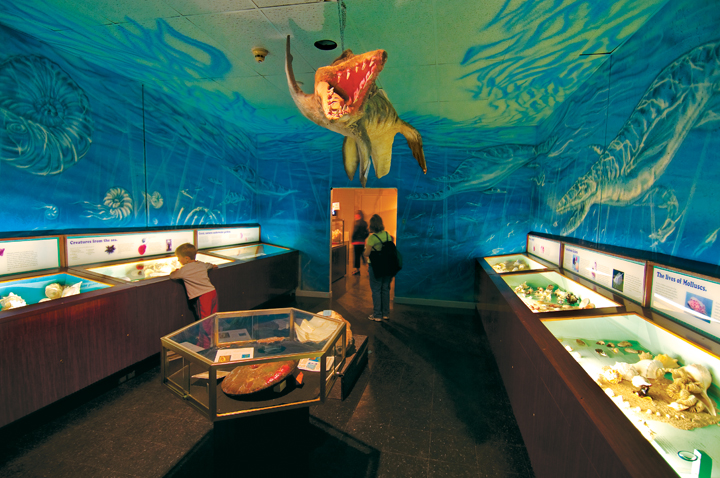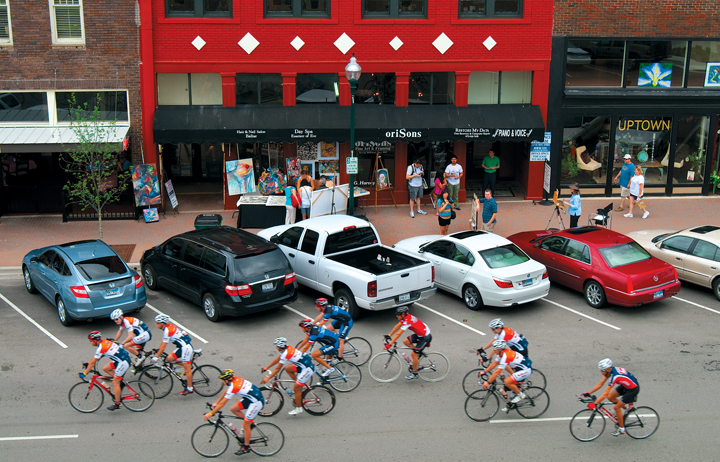
Spoons Café & Bar lures hungry guests with its all-day breakfasts as well as comfort food for lunch and dinner. The adjacent Spoons Garage & Bakery draws crowds craving coffee and pie. (Photos by Kevin Stillman)
On a quiet weekday afternoon in McKinney’s downtown historic district, a guitar player is picking out a tune in the shadow of Collin County’s 1876 courthouse, now reborn as the McKinney Performing Arts Center. These streets, which bustled in the 1870s when cotton made McKinney the commercial center of the county, still hum with residents and visitors alike, who come to explore boutiques, restaurants, and galleries.

When artists are working on the street, an eager crowd of onlookers descends on McKinney’s downtown historic district, which is among the largest in Texas.
But the well-preserved historic district—one of the largest in Texas—is only part of the pull. In the summertime, crape myrtles exploding with blooms line the main thoroughfares and green spaces. Year round, three wineries offer tastings and tours, a nature center and science museum provide encounters with wildlife, and cultural attractions include film screenings, live music, theater, and living-history reenactments of the county’s 19th-Century history. McKinney lies only 30 miles north of Dallas, but in some respects, it feels worlds away.
I’ve passed the McKinney exit a few miles from my home in Grapevine many times over the years, but I decided to drive into town and investigate after friends and acquaintances raved about the restaurants, shopping, and more.
As I head down Tennessee Street, one of the main avenues in the historic district, I drop in to visit with artist Laura Moore, who paints and exhibits her works in a bright, 1800s building that once served as a cobbler’s studio. Moore, who left a career in computer science to become a painter, graduated in 2006 from the Art Institute of Chicago, and now works in a variety of media and styles. Along with her own works, Moore shows contemporary pieces by Texas and national artists, including abstract pieces by Annie Lee of nearby Allen, who specializes in realistic portrayals of African-American life and culture.
The wall of windows at Laura Moore Fine Art Studios complements Moore’s fascination with shifting light and reflection, a fortuitous marriage that guarantees a different gallery experience every time you visit.
After I leave Moore, a yellow-and-blue sign that reads ”Alternative Furnishings” on Louisiana Street catches my eye. Inside, McKinney native Charm Cameron presides over a collection of unusual architectural antiques selected for her downtown shop by buyers who scour locales across the globe in search of hand-carved doors and mantelpieces, handwoven textiles, iron railings, chandeliers, and other artisan-made pieces. “I try to find out the stories behind the items,” says Cameron. “Whether something came from a flea market in Italy or a cathedral in France, it’s wonderful to keep the history alive in a new home.”
It’s no wonder that so many designers frequent her shop.
This little stretch of Louisiana Street holds another cache of antique pieces leading contemporary lives: Karen Dawkins’ shop, Smitten, blends old and new with an inventive sense of whimsy. Dawkins, who ran an antiques mall in town for more than a decade, says she has always liked antiques, especially when they’re given a new function and brought back to life for a modern environment. The shop’s motto is “reuse, repurpose, refresh,” which the shop does to great effect. Pillows made with vintage buttons and petticoat trim, picture frames fashioned from antique pressed-tin ceiling squares, and jewelry made from found objects like seashells and keys prove the ultimate in creative recycling.
In fact, repurposing on a grand scale informs the entire historic district, with its chic shops behind facades built of brick worn soft by time. In the 1950s, downtown supported five movie theaters, and one—the Ritz—survives today as a collection of businesses that includes a salon, a jewelry store, a wine-tasting room, and a 12-by 24-foot boutique called Sharla’s. Here, custom-made cabinetry, brown marble floors, antique chandeliers, and French and Italian music create a sophisticated, welcoming environment for owner Sharla Bush’s private skin-care line (developed by East Coast plastic surgeons). Bush also carries exclusive brands such as Le Clerc, Carthusia, and Bond No. 9, along with shaving accouterments, candles, Venetian-glass soap dispensers, and other elegant bath accessories.
Near noon, crowds begin to amass at Spoons Cafe & Bar on the corner, a 1920s-era Texas Power and Light Company building converted to a casual eatery with red-and-yellow-striped awnings out front and shading the patio. I join in, and am tempted by all-day breakfast dishes such as migas and house-made granola, and calorie splurges like fresh-baked pies, cherry cobbler, and cheesecakes. But I wind up ordering the Spoons’ Sig Salad, a mix of baby spinach, golden raisins, strawberries, and blue cheese-a lively sweet-and- salty combination-though the BLTA, made with applewood-smoked bacon, avocado, and a lemon-basil mayonnaise, almost made the cut.
Large windows and an open kitchen keep the cafe cheery and comfortable inside. The adjoining Spoons Garage & Bakery—where the power company once sheltered its trucks-is now a coffeehouse serving specialty coffees and teas on vintage-TV trays. Here, you can re-energize at a well-used science-lab table, surf the Internet, and admire (or purchase) a piece of the Garage’s ever-changing collection of funky antiques.
Next up on my McKinney must-see list: lodging. And one of the best spots in town is right across the street.
Visitors will find several well-appointed B&Bs in the historic district, but for a boutique-hotel experience, check out the four-story, 45-room Grand Hotel. The elegant gem opened in 2007 in the renovated 1880s Heard Opera House and Heard Mercantile building. The Grand pampers guests with Frette robes and linens in period-decorated rooms, a fitness center, and modern bathrooms outfitted with gleaming granite and glass. The hotel’s restaurant, Rick’s Chophouse, offers room service, but it’s a shame to miss the club by ambiance here-leather booths, original wood floors, iron chandeliers. Rick’s specializes in steak, but also serves Texas quail, buttermilk-fried chicken, and fare such as elk medallions.
After a look at rooms and a chat with bubbly front-desk clerks happy to share what they know about McKinney, I’m ready to walk off lunch, and I know just where to go.
A visit here isn’t complete without a trek to the Heard Natural Science Museum & Wildlife Sanctuary, a 289-acre wooded preserve about five miles south of downtown. Seven hiking trails wind through blackland prairie, woodlands, and wetlands habitats. No matter the season, you’re likely to spy (and hear) some of the hundreds of bird species that nest here or migrate through. In the native plant garden, agarita and red bay begin to flower in early spring, and the tall oaks along the trails provide shade in the summer for picnicking.

The Heard Natural Science Museum & Wildlife Sanctuary brings natural history to modern-day relevance.
Inside the museum, kids can dig for fossils in a replicated dig site, and learn about snakes, rocks, minerals, and marine life; this part of North Texas was once covered in Cretaceous seas.
The choice for supper is a no-brainer: Everyone I’ve spoken to so far has urged me to try Café Malaga, a Spanish tapas restaurant that had just moved to a large location with sprawling decks about two-and-a-half blocks from the Performing Arts Center. Red interior walls and vibrant yellow tablecloths create a warm setting for exploring the cuisines of Spain and North Africa. Outside, on an expansive, bi-level patio cooled by misters, diners overlook crushed granite pathways, an herb garden, and a stone fountain.
Cafe Malaga’s emphasis on tapas (small plates designed for sharing) means meals are a fun experience with lots of sampling. First up: a delicious, salty-crunchy plate of three mesquite-grilled, prosciutto- wrapped asparagus spears, followed by patatas bravas, a small platter of fried potatoes tossed in a spicy North African chili sauce. Next, my server recommends one of the restaurant’s bestsellers- strips of paprika-dusted, mesquite-grilled hanger steak, drizzled with a tangy, blue cheese aioli.
I caught up with owner Annie Stokes about a week later at the Saturday farmer’s market at nearby Chestnut Square, where she sells bacon-wrapped dates and other signature dishes from the restaurant. She grew up in England, but the inspiration for Cafe Malaga came from her Spanish grandmother. “Being British, I always thought I’d someday open an English tearoom,” she says. “Then when I first set foot in Spain, I found the food phenomenal and the dining experience relaxing and inspiring. I knew my friends in Texas would feel the same way. And I thought, ‘Of course! It’s ta pas, not tea!”‘
Chestnut Square Historic Village, just a few blocks south of the downtown square, represents life in Collin County from 1850 to 1930, when the railroad and cotton farming brought prosperity to the North Texas prairie. Six homes with period furnishings, a general store, a wedding chapel, a smokehouse, and a replica of a one-room schoolhouse welcome visitors for self-guided and guided tours, and a visitor’s center houses the world’s largest collection (300 strong) of historic ice cream freezers, some dating to the mid-1860s.
On Saturdays from March through October, the Chestnut Square Farmer’s Market takes place here, with dozens of vendors selling produce, breads, jams and jellies, and other foodstuffs, along with jewelry, ceramics, and locally made products.
I made a return trip to McKinney just to take in Chestnut Square and the market. Though a stiff, cold wind drove the vendors home early, families who braved the weather to amble through the compound enjoyed a warm welcome from volunteers versed in McKinney history, and bacon-wrapped dates were still on sale at Stokes’ table. Here, heartfelt pride in the past meets McKinney’s creative, vibrant present—the winning combination that will keep you coming back, too.
McKinney
McKinney is about 30 miles north of Dallas, in Collin County. For more details about lodging, restaurants, and attractions, call the McKinney Convention & Visitors Bureau at 888/649-8499; www.visitmckinney.com. Information about sites in the story follows.
Shopping
- Laura Moore Fine Art Studios, 107 S. Tennessee St. Call 214/914-3630.
- Alternative Furnishings, 105 W. Louisiana St. Call 972/562-0716.
- Sharla’s, 103 E. Virginia St., Ste. 101. Call 214/ 544-2200.
- Smitten, 118 E. Louisiana St. Call 972/529-6994.
Dining
- Café Malaga, 107 S. Church St. Call 972/542- 9996.
- Spoons Cafe, 100 E. Louisiana St. Call 972/ 548-6900.
Lodging
- Grand Hotel, 114 W. Louisiana St. Call 214/726-9250.
Outdoors and History
- Heard Natural Science Museum & Wildlife Sanctuary, 1 Nature Place. Call 972/562-5566.
- Chestnut Square, 315 S. Chestnut St. Call 972/562- 8790.









